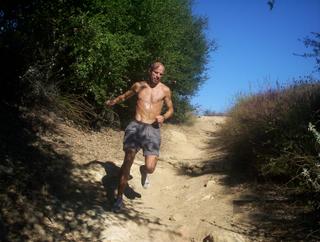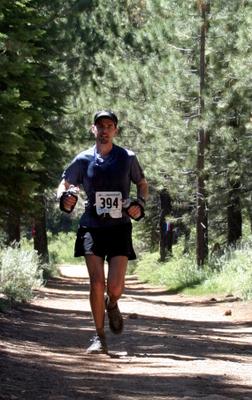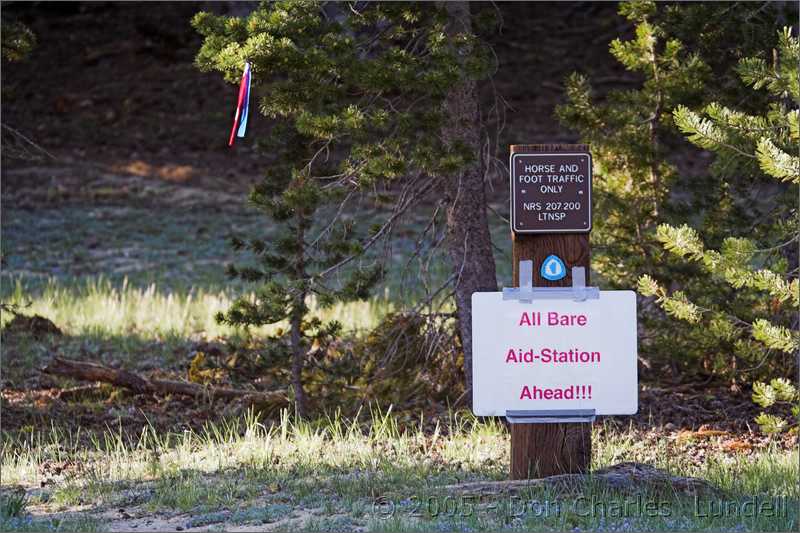For those of you following the
2005 Trail Runner Magazine (TRM) Trophy Series, you'll recognize the name Dale Reicheneder as the current #1 runner for the
Marathon-and-Under Series. Dale set a furious pace from the beginning of the season, racing over 18 races all over the U.S. and Canada, and showing all of us it is possible to maintain a 2+ race per week schedule. Yet it hasn't erased the smile from his face, or his willingness to cheer on every racer on the trail. Dale took a (short) break from his running to catch up with me over e-mail, and tell us a bit about how this former track star found his way to the trails.
 (Dale finishes strong at the Catalina Marathon, March, 2005)
(Dale finishes strong at the Catalina Marathon, March, 2005)SD: How long have you been trail running? Were you an athlete when you were in high school/college, and if so, what sports?
DR: I apologize in advance for the long, probably disjointed response. I grew up in Colorado, but after my parents separated when I was about nine, I found myself in northern Saskatchewan on a farm my Dad subsequently bought, every summer. In between picking rocks, clearing new land, cultivating, etc., I would go out for a mile jog here and there. As I got older, my training distances, like for everyone, increased. The open space the farm fields provided was really my first exposure to trails, making my own on the farm with picks, axes, shuvels and a motorcycle. During the school year in Colorado, I began implementing some trail runs within my regular training regimen which was mostly roads and track during the school year. I ran and competed in organized track events, mostly the 800 and mile since I was in 5th grade, but I also attempted pole vaulting with disastrous results. I played soccer since I was 5, until my senior year in High School, when I switched to Cross-Country. It turned out to be a great decision as we won State, though I was always better individually on the track.
I continued competing through College, though I continued to be a much better trackster, but found myself transfering twice, eventually ending up at Pepperdine. The big switch came after during law school and then for the first few years as a practicing attorney, I was not running regularly because I was studying/working so much. As a result of about 5 years of sitting on my ass with a pop and pretzel type diet, I became horribly overweight, approaching 200 pounds (I'm currently 5'11", 147). One day, about 4 years ago, I saw a sign for a 14 mile trail race in Malibu Creek, about 3 minutes from my home. I entered it. I had the most miserable time of my life and it took me about 4 hours to re-hydrate...sitting on a bench in the park after everyone was long gone. It was a reality wake up call that I was not in good health. I decided at that juncture to use the trails to get back into shape. Trail runs are the best for stress relief and I really caught the bug and it's now a part of my life.
SD: Why trail running? What do you enjoy about it?
DR: First, my High School track and cross-country coach, Steve Lohman, who remains a great friend and mentor, always encouraged training on dirt. Again, as I'm sure is the case for most people, just being away from my normally chaotic and stressful day, out on the trails...is great. Seeing the wildlife, the quiet and solitude. But also the people I've met and train on occasion with, are great people who's company I really enjoy. Of course sharing rattlesnake scares are a blast!
SD: Where's your hometown, and what are your favorite trails in the area?
DR: My hometown is in Colorado, graduating from Cherry Creek High School. We are spoiled at Creek, having easy access to Cherry Creek Reservoir providing some great runs. The area, too, has a lot of trails next to canals and waterway management systems. Close to my house is a canal system where you can run as long as I would ever care to.
SD: What attracted you to competing in the TRM Series this year?
DR: This is the $10,000 question! Part of the reason was that I continued racing in the Malibu Creek Trail Challenge and the Bulldog events. Last year I discovered that you had mentioned me in a blog as a "local favorite". Although a compliment, it also motivated me because I thought I could be competitive in the TRM National Championship Series.
Since that initial decision, the TRM Series has taken on an incredible life of its own. I have seen so much more of America. I'm truly blessed to have engaged in this quest. It's been great traveling and meeting people from all over the country and feeling welcome everywhere.
SD: What have been the biggest surprises so far in the season?
DR: I am most surprised that you and Michael Robbert are still too close for comfort! Secondly, that I can no longer race at altitude worth crap, despite growing up in Colorado.
SD: What has been your favorite race so far?
DR: This is a tough one. After 18 races, well, I hope I don't sound biased, but the Malibu Creek Trail Challenge is my favorite, although I preferred the event more when it was headed by a different race director, Stan Swartz, who has been a big inspiration for me to participate in Trail events. Stan remains the director of Trail Runners Club here in the Palisades, that I run with when I can. The new director, in my opinion, is starting commercialize the event too much, even trying to prevent Bandits from running...ridiculous. In my opinion, I think bandits are a fun aspect of the race. In any case, the course caters more to my strengths and likes and its only 3 minutes away!
Best marked course is the Golden Gate Canyon Trail Run. Its race director, Adam Feerst, knows how to put on a great event...it's too bad it takes place at 9,500 - 10,000 feet! Although I walked a lot of it...at least I didn't get lost! I read in your interview with Bernie Boettcher that 10,000 feet is a bit of a strain on him since he only trains at 6,000 feet. Hmmm, I train at 16 feet, no wonder Bernie and 20 others obliterated me at Golden Gate Canyon!

(Dale cranks down the trail in Malibu Creek State Park, photo courtesy of Damon Lymon)
SD: What has been your toughest race so far?
DR: Top of the list has to the Kusam Klimb 23.2K in Sayward, British Columbia. First, I flew into Victoria on Vancouver Island, rented a car and drove 5 hours to the start of the race. I arrived at 5:30 a.m., the race started at 7:00 a.m. After pulling an all-nighter, I was then faced with a course that was more akin to climbing K2, than a trail race. I quickly realized I didn't get the memo to bring my Batman Utility Belt. At the start, I saw racers with ankle braces, body padding, ski poles.... Hmmm, here I was in my usual shorts and shirt. The first mile was ok, then I spent miles 2 through 6 on my hands and knees, going straight up, using ropes to climb, 3 inch-wide ledges overlooking 25 foot drops. It was cold and raining, I slipped and fell too many times to count. Power walker types passing me. Then on the downhill portion, you go straight down for several miles. I spent most of it on my ass. A bunch of crazy locals were screaming on the way down, suicidal. There were 10 foot drops I jumped down, multiple large water crossings with freezing water. Nothing but bouncing from one rock to the next. No trail. Once I fell so hard that I laid there for a minute or two slowly making sure nothing was broken. Ridiculous. Then it opened up for a couple of miles of trenches, with water flowing through each one...I hate that. Finally the course opened up for about 3 miles of good solid trail racing terrain...slight downhill and straight, reasonable footing. I probably ran 3 sub 5:00 miles in this portion and passed a number of people...reminded me a bit of those 4:07 miler days. Then a few miles of more rocky trenches. Finally a mile on the roads and finished. The race totally tore up my body and contributed to my lousy races the following week. Never again.
SD: The five toughest races so far?
DR: In order, starting with the toughest: Kusam Klimb in British Columbia (this one is way up there); Wahsatch Steeplechase in Salt Lake (a far off second); Redwood Trails' Waterfalls of Big Basin in Boulder Creek, CA; Malibu Creek Trail Challenge in Malibu, CA; and tied for fifth, Catalina Marathon , Escape from Prison Hill in Nevada, and the Afton Trail Run in Minnesota (I ran this one after another all - nighter).
SD: Biggest pet peeves about the races so far?
DR: This one is easy. The biggest pet peeve is that race directors seldom provide a map on the web-site with directions how to get to the race. If directions are provided, they can only be interpreted by locals. One example is that both Michael Robbert and I spent about 2 hours driving around Salt Lake looking for the start. The map provided was totally inadequate. Even when I email race directors for directions to the start from the airport...I get bad directions. Of course, I don't realize how bad they are until I'm on the road, probably around midnight and completely lost.
SD: What's your favorite distance? Have you ever done any ultras, or desire to?
DR: My favorite distance is roughly the half-marathon distance, although there seem to be a lot of 25K distances which are getting too far for me. I have zero desire to enter into an ultra. In my world, 26.2 miles is an ultra! The reality is that my body just can't physically perform at a level I desire, much past a half-marathon. I'm a short distance guy.
SD: Do you train with any running clubs or coaches?
DR: Notwithstanding the fact that I'm traveling nearly every weekend to a different time-zone, I run with the Trail Runner's Club. I mostly coach myself, but I still visit with my coach from high school and Dick Kampmann at Pepperdine University, where I do approximately 50% of my training, including swimming.
SD: You sure do race a lot - what's your recovery strategy when you race every weekend? Are you able to train in between races at all?
DR: Good question. In the early stages of the season I was, unfortunately, more self-destructive. Probably because of the personal matters described earlier, training and racing was done with stupidly ferocious intensity. The first 4 races included two marathons and two half-marathons, and I found myself injured one month into the season. This was basically the period I collided with a mountain biker, breaking my rib, severely twisted my ankle in a gopher hole and so forth. I simply wasn't paying attention to what I was doing. I am much smarter about things now. I typically only do a few miles the day following a race instead of 10 or something. I increased my pool swimming time and I eliminated the marathons. I spend more time in recovery mode, but still log 50 miles or so weekly. Normal off-season is about 80 per week, with swimming. Swimming is probably the biggest single key ingredient to my being able to continue with the Series. Also, as tempting as racing every weekend is, I am putting in some weekends off for restoration.
SD: Any nutrition advice (race or training)?
DR: I, for the most part, eliminated fried foods, no alcohol, only a rare dessert. I probably consume a carb to protein ratio of 60-40. I think everybody's different with different nutritional needs. I know I function best with a nice steak every Saturday night! Largest meal is lunch, usually only a salad, yogurt or some popcorn at night. Peanut butter and a banana for breakfast. Lots of tea and Gatorade - Endurance Formula is great. A couple of protein bars a week for the sweet tooth fix.
SD: How many races do you think it's possible to do in the TRM Series this year?
DR: I've done 18 races so far. I can't say for sure how many more. What you and Robbert do the remaining half of the season will have an impact on what I do...my money is running out!
SD: Do you think there are areas of improvement for the TRM Series?
DR: I think it is important to mention that TRM is doing and has done a phenomenally great job on this Series. Sure, there will be some slight modifications as time goes on, but overall it has been an incredibly well done Series. I would not have invested the time, money and effort in this Series if it wasn't being administered in first class manner, with credibility as a true Championship Series. I look forward to hopefully working with TRM, you and Robbert, to possibly help make the event even better.
SD: Who/what inspires you to keep at it?
DR: God. The goal of winning. Seeing so many great things in America, totally unexpectedly. Meeting so many great Americans, totally unexpectedly. Having numerous new great stories to share.
SD: Any disappointments?
DR: All the wrong turns I tend to take in races!
SD: Best airports?
DR: In terms of user friendly and rental car access, easily, number one is Tampa Bay; Charleston, WV and Toronto.
SD: Worst airports?
DR: San Jose. I felt like writing the Mayor of San Jose. There is absolutely no excuse for the BS system at that place.
SD: What states have you traveled to?
DR: Some of these more than once - Maryland, Mississippi, Oregon, Florida, Washington, Nevada, West Virginia, Toronto, Ontario (Canada), Sayward, British Columbia (Canada), Utah, Colorado, and Minnesota.
SD: Biggest thanks?
DR: To my law firm in Sherman Oaks, California,
Loewenthal, Hillshafer & Rosen, and the partners for allowing me the opportunity to leave early on Fridays.
SD: Thanks for sharing, Dale, and good luck with the rest of the season!







